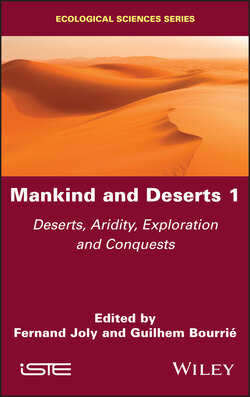Читать книгу Mankind and Deserts 1 - Группа авторов - Страница 11
1.3. The world of deserts
ОглавлениеIn these conditions, it is futile to try and establish a clear definition of a desert that would be applicable in all cases. However, transecting a desert (the Sahara, for instance) from its periphery to its center (or the other way around) could help in revealing the most specific characteristics of the desert state, as is found, to varying degrees, in all deserts around the world.
The characteristic that can be spotted by even the untrained eye is the rapid degradation of any green cover. If someone were flying over it, in just a few minutes the view of greenery from the plane would shift from a clear forest or savanna to a disjointed steppe until it disappears altogether. On land, however, we can see that this degradation involves a gradual decrease in both the number of individual plants as well as the number of species (biodiversity), leading to increasing homogeneity. This is compounded by the unequal distribution of vegetation, spread out on the slopes and interfluves, concentrated in the wadis and showing significant variations in vitality depending on the rainfall, with certain plants rapidly blossoming after a downpour. This decrease in vegetation is accompanied by an equal decrease in the fauna in the region, especially of the animals that are most dependent on vegetation and water.
The hydrographic disruption manifests as the rarefaction of drains and a growing anarchy in water flows. Concentrated drainage divides into independent networks that become fewer and fewer in number and less and less hierarchic, with the water finally forming isolated channels or even disappearing completely. Most channels are dry in all seasons and are only revived during a flood. Apart from the large, exorheic4 allogenous rivers, such as the Nile or the Euphrates, water flow is exclusively local and linked to precipitation, which is itself intermittent and irregular. Between channels, during the rains the surface of an interfluve may often be swept by diffuse flows, in sheets or numerous and changing gullies. All these drains, except for those along the maritime coasts, are endorheic5, that is, they lead to closed basins of all sizes, which are numerous and independent, where they are lost. There is also the extreme case of an arheic region6 where there is a complete absence of water flow.
The morphology of a desert is also formed of unique features of relief, owing to the specific conditions of the desert model. The disaggregation of hydrographic networks reduces the preeminence of valleys in a landscape. The desert is flat until it enters the mountains. The horizontal shapes or shapes with very small slopes, plains, plateaus and glacis7 overpower sharp reliefs or reduce them to eroded tussocks or to small isolated massifs (inselbergs8). And everywhere you have evidence of the wind at work. The sweeping winds shave off the finest elements from the rocky floors and alluvial sheets and accumulate them into dunes, scattered or grouped together (ergs).
The scarcity of water and arable land leads to a dispersion of land use and sedentary life, with sedentary populations tending to settle around better land, or land that is less poor. Humans seek alluvial land, which is more or less regularly flooded or is, at least, irrigable using ancient and varied systems. This leads to populations, cultures and habitats (oasis) being scattered (around water bodies) or arranged in a linear manner (along a river), further accentuating the powerful impression of a void that a desert creates. A relative void, however, because although the isolated and precarious water bodies, springs or wells cannot sustain agriculture by themselves, they can sustain an active, if highly scattered, nomadic life.
To summarize, we can identify five factors that make up the concept of a desert and that characterize deserts, to varying degrees and based on various combinations of different geographic features:
1) the most general of these is aridity (see Chapter 3, p. 65), an obvious aspect that is, however, difficult to define and measure, as it involves the scarcity of precipitation, intense evaporation as well as the nature of soil (substratum and superficial formations);
2) problems with water (see Volume 2, Chapters 1–3) are largely dependent on the previous point. While these problems involve the modalities of flow and how these affect the landscape morphology, they also involve water inputs and water capacity in the region, as well as the various ways in which inhabitants of the region use these resources;
3) the presence of salts (see Volume 2, Chapter 4), whose nature and abundance depends on the highly varied combinations of aridity and the input of dissolved salts in water, a condition that makes the water non-potable but also serves as an essential resource. This mineral wealth can be transported by the caravans for trade;
4) the wind (see Volume 3, Chapters 1 and 2) is omnipresent and especially strong in the desert. All along its complex paths it lifts up, transports and deposits sands and dust;
5) and finally, an essential factor is that of space, which contains all the other factors. There is, first of all, the large expanse, an inordinately vast area in some deserts. Then there is also the bareness of the biological environment. The relief forms, which depend on unique legacies which, to greater and lesser extents, are ancient. Finally, you have the inhabitants, both sedentary and nomadic, who have, over the centuries, been able to construct and maintain a veritable “desert civilization” (see Volume 3, Chapter 3).
Over the course of these volumes, we will examine these five basic factors in detail. However, we begin with an overview of the history of our exploration of the deserts.
